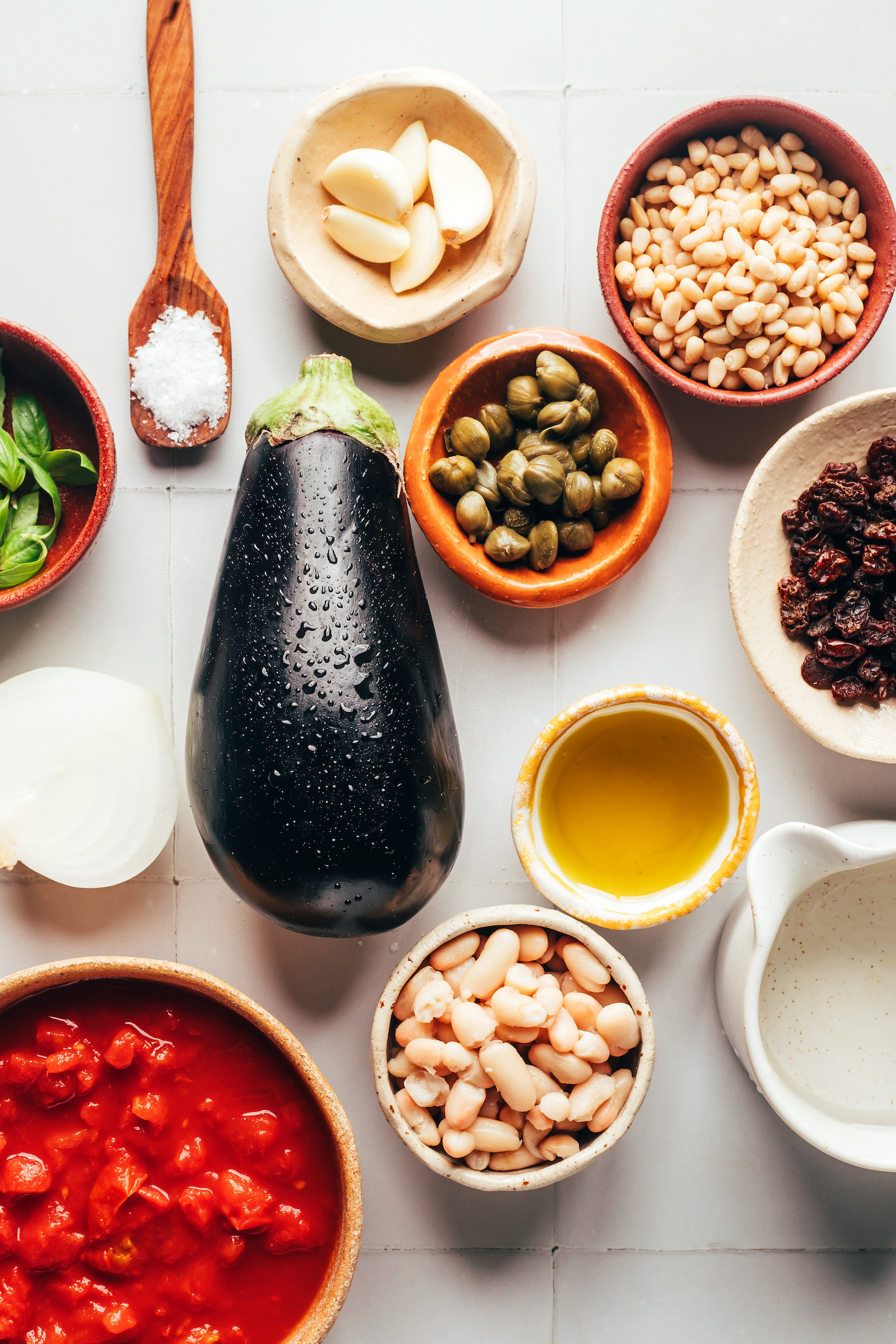
Have you tried caponata? If not, let us introduce you! It’s a delicious Sicilian eggplant dish with sweet and savory flavor, and we ADORE it! While commonly served as an appetizer or side, it’s worthy of being a main when a little protein and fiber are added in. Introducing: white bean eggplant caponata!
Made in 1 pan with just 10 ingredients, this is an effortless, plant-based entrée that pairs well with pasta, polenta, bread, or even mashed potatoes. Let us show you how it’s done!

What is Caponata?
Caponata is a sweet and sour cooked eggplant dish from Sicily, Italy. It’s traditionally made with chopped eggplant seasoned with olive oil, tomato sauce, celery, olives, and capers.
There are many variations of caponata, with the ingredients varying by region. Other vegetables are sometimes included, and pine nuts and raisins can be incorporated, too. Our inspired version has many of the elements of the traditional dish, but with a non-traditional add-in: white beans!
How to Make White Bean Eggplant Caponata
This EASY, 1-pan dish begins with sautéing onion, eggplant, and garlic in olive oil with a little salt until the eggplant begins to soften.

Then we add caponata classics including tomatoes, capers, and raisins, which creates the sweet, savory, and slightly tangy sauce. Adding water ensures very tender eggplant, while white beans add protein and fiber.

Once the sauce is thick and fragrant, we stir in fresh basil and toasted pine nuts. Then it’s ready to enjoy!

We hope you LOVE this dish! It’s:
Saucy
Comforting
Sweet + savory
Nutty
Easy to make
& SO delicious!
Caponata can be enjoyed in many ways! It’s delicious with toasted crusty bread or over pasta, polenta, or mashed potatoes.
More Eggplant Recipes
- Moroccan-Spiced Eggplant and Tomato Stew
- Crispy Gluten-Free Eggplant Parmesan
- Sesame Eggplant & Almond Butter Tofu Bowls
- Smoky Harissa Eggplant Dip
If you try this recipe, let us know! Leave a comment, rate it, and don’t forget to tag a photo @minimalistbaker on Instagram. Cheers, friends!

White Bean Eggplant Caponata (1 Pan!)
Ingredients
- 3 Tbsp olive oil
- 1 medium yellow onion, diced (1 onion yields ~2 cups or 200 g)
- 1 medium eggplant, cut into ~1/2-3/4-inch cubes (1 medium eggplant yields ~6 cups or 425 g)
- 5 medium cloves garlic, minced
- 1/2-3/4 tsp sea salt
- 1 (15-oz.) can crushed tomatoes
- 1 (15-oz.) can white beans, drained (we like cannellini beans // or sub ~1 ½ cups homemade)
- 3/4 cup water
- 1/3 cup raisins
- 2 Tbsp capers
- 1/4 cup pine nuts (lightly toasted for best flavor)
- 1/4 cup freshly chopped basil (optional but recommended for best flavor!)
FOR SERVING optional
- Pasta
- Polenta
- Toasted crusty bread (whole wheat or gluten-free)
- Mashed potatoes
Instructions
- OPTIONAL: If your pine nuts are not toasted, you can toast them (for best flavor) by adding to a dry skillet and cooking over medium heat for 4-5 minutes, stirring often to prevent them from burning (it happens quickly!). Remove the pine nuts from the pan and set aside.
- Heat oil in a large rimmed skillet over medium heat. Once hot, add diced onion and cook, stirring occasionally, until translucent — about 3-4 minutes. Next, add the eggplant, minced garlic, and salt. Cover and cook for about 8-10 minutes, stirring occasionally, until softened.
- Add crushed tomatoes, white beans, water, raisins, and capers. Lower the heat to medium-low and cook (uncovered) for ~20 minutes, stirring occasionally, until the eggplant is very tender and the sauce is thick and fragrant.
- When the sauce has thickened and the eggplant is fully cooked, stir in the toasted pine nuts and optional basil. Taste and adjust as needed, adding more salt for overall flavor, capers for zing, raisins for sweetness, or olive oil for richness.
- Serve warm with toasted crusty bread or over pasta, polenta, or mashed potatoes.
- Best when fresh. Store leftovers in an airtight container in the refrigerator for up to 3-4 days or in the freezer for up to 1 month. Reheat in a skillet on the stovetop until warm, adding a little water as needed.








Kara says
What could you sub for pine nuts? I can never buy really fresh tasting ones.
Hi Kara, you can leave them out! Other readers have also mentioned subbing lightly toasted sunflower or pumpkin seeds, but we aren’t sure if they soften as well. Hope that helps!
The Vegan Goddess says
Wow, I finally made this and it is delicious!
I subbed little pieces of dates for raisins since I didn’t have them and they’re just as naturally sweet and a great addition to this dish. And I subbed sunflower seeds for pine nuts since I didn’t have them handy and toasted them. I didn’t add capers because they’re too salty for my taste but everything else was the same as written except for basil, which I didn’t have on hand.
I paired it with spiralized zucchini as my “pasta”. The next time I make it, I might try it with mashed golden potatoes for the color.
Lovely! Thanks so much for sharing! xo
Lizzy says
This is so so delicious! I made the recipe as written, except I used slightly less onion and I added some zucchini with the eggplant. We’ve made this twice in a week because we love it so much. Served with bread on the side. Love a one pan meal that tastes this good!
Whoop! We’re so glad you’re enjoying this one, Lizzy. Zucchini is a brilliant addition. Thanks so much for sharing! xo
Reenie says
This came together so quickly! Had to make small adjustments: did not have capers or pine nuts so added a bit more salt (shrug emoji) and did not have raisins so used sun-dried tomatoes. Nom nom nom thank you, MB!
Love your creativity in working with what you had, Reenie! Thank you for sharing! xo
Paulette says
What is a good substitute for capers?
Hi Paulette, you could leave them out or sub green olives.
Stevie says
Not only is this dish super easy to make it’s SO good! I served it on polenta and it was a hit.
I *almost* decided not to put raisins in- but let me tell you they added so much to the flavour, I highly recommend making this recipe as it is written.
Thanks for yet another incredible recipe Minimalist Baker!
Whoop! We’re so glad you enjoyed it, Stevie. Thank you for sharing your experience! xo
The Vegan Goddess says
This looks amazing and is on my “must try” list!
How did you make the mashed potatoes? Did you bake or broil them to make them crispy on the edges as shown in the photo?
Yay! We hope you love it! We’re not sure which photo you’re referring to? The first photo is on toasted bread and the last photo is polenta. Hope that helps!
The Vegan Goddess says
Oh, I mistook the golden polenta for mashed potatoes. Thanks for the clarification!
Sheila says
This recipe popped up in my inbox yesterday on a day where I really needed some dinner inspiration. It came together quickly and easily and is absolutely delicious, will definitely be making again!!!
We’re so glad the recipe was timely and you enjoyed it! Thank you for the lovely review, Sheila! xo
Susan Ottwell says
Excellent, and I don’t even like eggplant all that much! I did sub sunflower seeds for pine nuts, and unsweetened dried cranberries for the raisins, as well as some zuccini in place of half of the tomatoes, too much tomato upsets my medication-irritated stomach. Made enough to box up three servings to add to my don’t-feel-up-to-cooking freezer stash. So many of your recipes are easy on the stomach, but full of essential nutrition, even on those days when I have no appetite and no sense of taste. I think they’ve really made the cancer treatments easier to tolerate. Thank you so much.
We’re so sorry you’re having to go through that, Susan! But glad our recipes have been helpful. Sending lots of love and healing your way! xoxo
Marina says
I was wondering how cranberries would go as a substitute. Glad you subbed them and let us know – I will now do the same when next I am in the kitchen!
SNL says
Funnily enough I was going to make a Mediterranean veg stew tomorrow – ratatouille but Italian flavour, but now I’m going to use this recipe as the base instead. Thanks :)
Yay! Let us know how it goes! xo
SNL says
It was great, but even better with the authentic agrodolce/sweet n sour element. Then it was 10/10, I can’t believe it’s vegan. Served with well cooked rice to replicate polenta texture. Made a few subs as necessary but still in keeping with the authenticity. Omitted raisins/dried fruit, added 1.5 peppers and 1/3 cup cooked green beans to replace deficit aubergine (my large aubergine was 267g), agrodolce makes the dish – 1tbsp/12g honey and 2tbsp/30ml red wine vinegar cooked into the dish, 4 shallots instead of an onion, fresh oregano instead of basil, probably 1/2 cup spicy red pepper dip that needed using up, good pinch chilli powder, 1 pound fresh tomatoes blended with 2tbsp* tomato paste to amp up the umami factor, 1 good tablespoon of nutritional yeast for umami, slightly more beans because I cooked from dry and lastly roasted pumpkin seeds instead of pine nuts.
Amazing! Thank you for sharing! xo